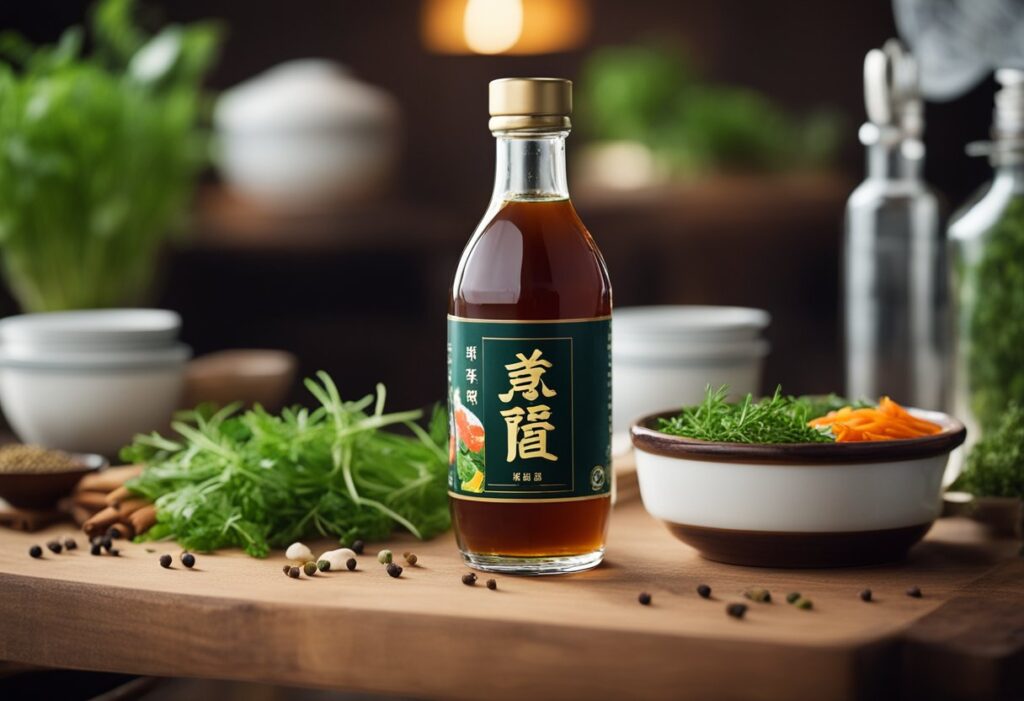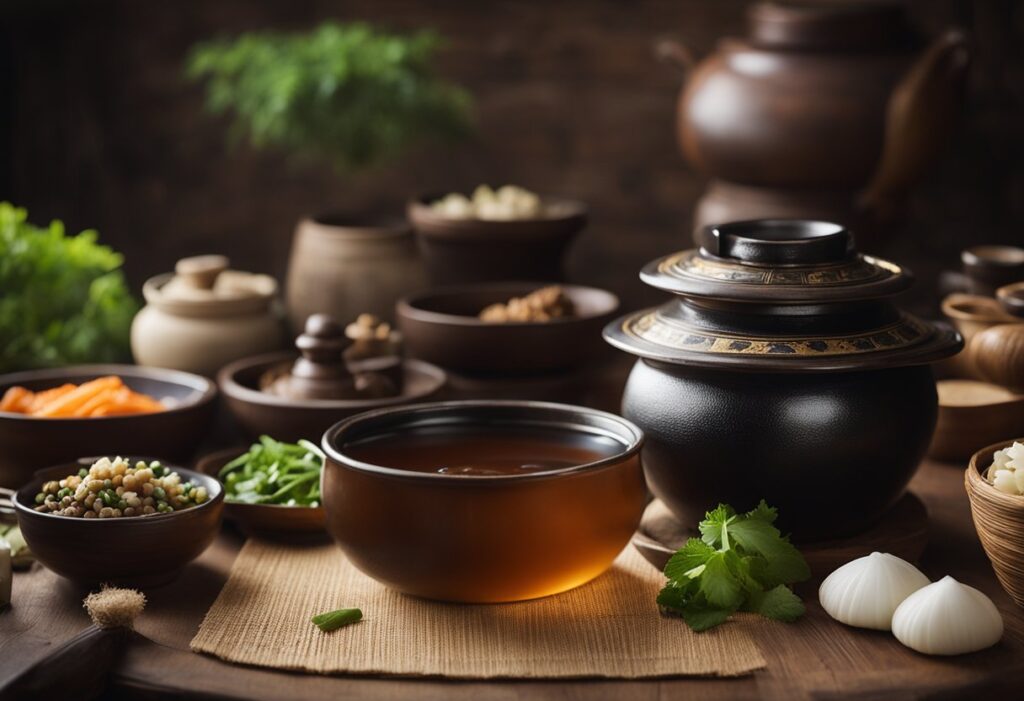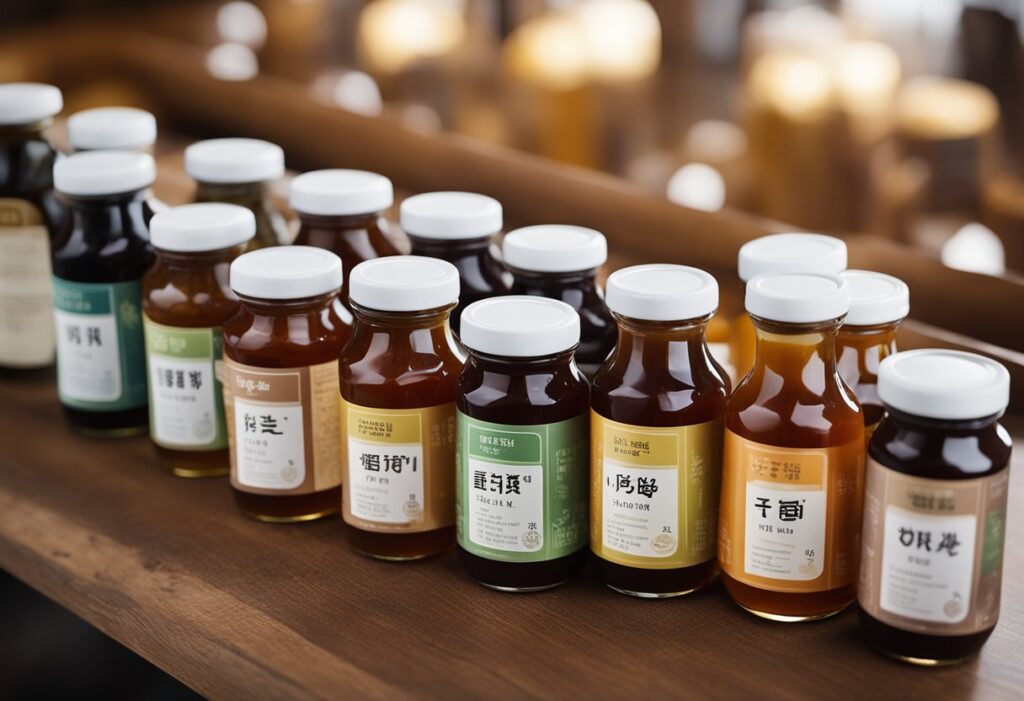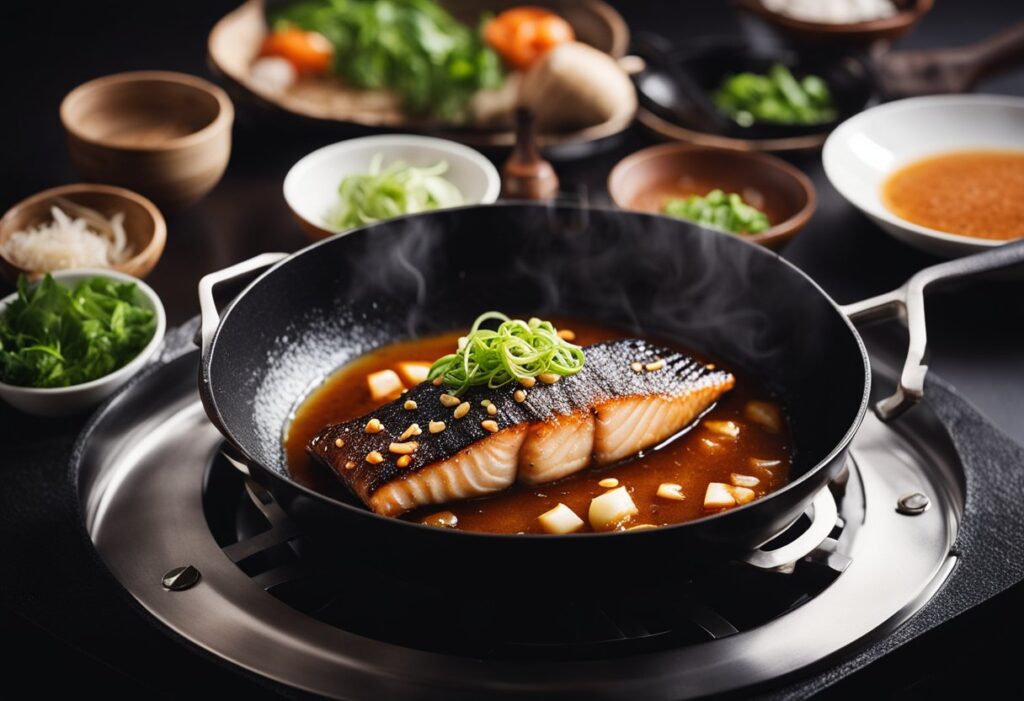Korean fish sauce, also known as aekjeot, is a traditional seasoning made from fermented fish. It is a staple ingredient in many Korean dishes, providing a unique umami flavor and aroma. The sauce is made by mixing salted and fermented fish with water and allowing it to mature for several months.

Korean fish sauce has a long history dating back to the Three Kingdoms period (57 BC – 668 AD). It was initially used as a way to preserve fish for long periods. Over time, it became a popular seasoning used in Korean cuisine. Today, it is still widely used in many dishes, including stews, soups, and marinades. The sauce is also used as a dipping sauce for vegetables and meats.
Historical Significance

Origins of Korean Fish Sauce
Korean fish sauce, also known as “jeotgal,” has a long history that dates back to the Three Kingdoms period (57 BC – 668 AD). It is made by fermenting fish, shrimp, or shellfish with salt and other ingredients such as rice, soybeans, and chili peppers. The fermentation process can take anywhere from a few months to several years, depending on the desired flavor and texture.
The earliest records of jeotgal can be found in the Samguk Sagi, a historical record of the Three Kingdoms period. It describes how the people of Goguryeo, one of the Three Kingdoms, made jeotgal by mixing salt and fish and leaving it to ferment in earthenware jars. Over time, the recipe evolved and spread to other parts of Korea.
Cultural Importance
Jeotgal has played an important role in Korean cuisine and culture for centuries. It is used as a condiment, seasoning, and ingredient in a variety of dishes, from soups and stews to kimchi and bibimbap. It adds depth of flavor and umami to dishes and is often used in place of salt or soy sauce.
Jeotgal also has cultural significance in Korea. It is a symbol of the country’s long history and tradition of fermentation, which is an important part of Korean cuisine. Fermentation is seen as a way to preserve food and enhance its flavor and nutritional value. Jeotgal is also associated with the sea, which has been a vital source of food and livelihood for Koreans throughout history.
In conclusion, Korean fish sauce, or jeotgal, has a rich history and cultural significance in Korea. Its origins can be traced back to the Three Kingdoms period, and it has been an important part of Korean cuisine and culture ever since.
Production Process
Ingredients
Korean fish sauce is made from anchovies, salt, and water. The anchovies used are typically small, whole fish that are high in protein and flavor. The salt used is coarse sea salt, which is added in a ratio of approximately 3:2 to the anchovies. The water used is typically filtered or purified to ensure the quality of the final product.
Fermentation Method
The production process of Korean fish sauce involves a natural fermentation method. The anchovies and salt are mixed together and left to ferment for several months in large earthenware jars called jangdok. During the fermentation process, the anchovies break down and release their flavor and nutrients into the mixture. The fermentation process is closely monitored to ensure that the mixture does not become too acidic or too salty.
Aging and Storage
After the fermentation process is complete, the mixture is strained to remove the solids and the liquid is aged for several months. This aging process allows the flavors to develop and mature, resulting in a rich and complex flavor profile. The aged fish sauce is then stored in a cool, dark place to preserve its quality and flavor.
Overall, the production process of Korean fish sauce is a traditional and time-intensive process that requires careful attention to detail and quality control. The resulting fish sauce is a versatile ingredient that adds depth and complexity to a wide range of dishes.
Types of Korean Fish Sauce

Korean cuisine is well-known for its unique and complex flavors, and one of the key ingredients that contribute to this distinct taste is fish sauce. Korean fish sauce is made by fermenting fish with salt and water, resulting in a salty, savory, and slightly sweet liquid that is used as a seasoning in many Korean dishes.
Anchovy Sauce
Anchovy sauce, also known as myeolchi aekjeot, is one of the most common types of Korean fish sauce. It is made from small anchovies that are salted and fermented for several months. The resulting sauce is dark brown in color and has a strong, pungent aroma. It is commonly used in soups, stews, and dipping sauces.
Sand Lance Sauce
Sand lance sauce, also known as kkongchi aekjeot, is another popular type of Korean fish sauce. It is made from sand lances, a type of small fish that is abundant in Korean waters. The fish are salted and fermented for several months, resulting in a sauce that is lighter in color and milder in flavor compared to anchovy sauce. It is commonly used in marinades, dipping sauces, and stir-fries.
Shrimp Sauce
Shrimp sauce, also known as saeujeot, is a type of Korean fish sauce that is made from small shrimp. The shrimp are salted and fermented for several months, resulting in a sauce that is pinkish in color and has a strong, salty flavor. It is commonly used in soups, stews, and dipping sauces.
Overall, Korean fish sauce is an essential ingredient in many Korean dishes, adding depth and complexity to the flavor profile. With its variety of types and uses, it is a versatile ingredient that can elevate any dish to the next level.
Culinary Uses

Traditional Dishes
Korean fish sauce has been a staple ingredient in Korean cuisine for centuries, particularly in traditional dishes such as kimchi, doenjang jjigae (soybean paste stew), and galbi jjim (braised beef short ribs). Its umami flavor adds depth and complexity to these dishes, making them more savory and delicious.
Modern Adaptations
In recent years, Korean fish sauce has gained popularity among chefs and food enthusiasts for its unique flavor profile. It has been used in various modern adaptations of traditional Korean dishes, such as Korean-style fried chicken, bibimbap, and bulgogi. Its versatility allows it to be used in a wide range of dishes, from marinades and dressings to soups and stews.
Pairing with Other Ingredients
Korean fish sauce pairs well with a variety of ingredients, including garlic, ginger, scallions, and sesame oil. It can also be used to enhance the flavor of seafood, meat, and vegetables. When using Korean fish sauce in a recipe, it is important to adjust the amount of salt and other seasonings accordingly, as it can be quite salty on its own.
Overall, Korean fish sauce is a versatile and flavorful ingredient that can add depth and complexity to a wide range of dishes, both traditional and modern. Its unique flavor profile and umami-rich taste make it a must-have ingredient in any Korean kitchen.
Nutritional Information
Korean fish sauce is a popular condiment in Korean cuisine that is made from fermented fish and salt. It is a staple ingredient in many Korean dishes, providing a unique umami flavor and enhancing the overall taste of the dish.
Here are some nutritional facts about Korean fish sauce:
- Serving Size: 1 tablespoon (15 ml)
- Calories: 10
- Total Fat: 0g
- Cholesterol: 0mg
- Sodium: 1280mg
- Total Carbohydrates: 0g
- Protein: 2g
Korean fish sauce is a low-calorie condiment that is free from fat and cholesterol. However, it is high in sodium, with one tablespoon containing 1280mg of sodium, which is more than half of the recommended daily intake. Therefore, it is important to use Korean fish sauce in moderation.
In addition to sodium, Korean fish sauce is also a good source of protein. One tablespoon of Korean fish sauce contains 2g of protein, making it a great addition to vegetarian and vegan meals.
Overall, Korean fish sauce is a flavorful and nutritious condiment that can be used to enhance the taste of many dishes. However, it should be used in moderation due to its high sodium content.
Buying Guide
Label Reading Tips
When looking to buy Korean fish sauce, it is important to carefully read the label to ensure that you are getting a high-quality product. Look for fish sauce that is made from anchovies or other high-quality fish, and avoid products that contain additives or preservatives. Also, pay attention to the salt content, as some brands may have higher levels of salt than others.
Quality Indicators
There are several indicators of quality to look for when choosing Korean fish sauce. First, consider the color of the sauce. High-quality fish sauce should have a dark, rich color, indicating that the fish was fermented for a longer period of time. Additionally, look for fish sauce that has a strong, savory aroma, which is a sign of high-quality ingredients and a well-fermented product.
Another important factor to consider is the level of umami flavor in the fish sauce. This flavor is created by the breakdown of proteins during the fermentation process and is a hallmark of high-quality fish sauce. Look for products that have a rich, complex umami flavor, as this will add depth and complexity to your dishes.
When shopping for Korean fish sauce, it is also important to consider the brand and reputation of the manufacturer. Look for brands that have a long history of producing high-quality fish sauce and that are known for using only the best ingredients. By following these tips, you can ensure that you are getting the best possible product and can make delicious, authentic Korean dishes at home.
Storage and Preservation
Korean fish sauce is a fermented product that has a long shelf life, but proper storage is essential to maintain its quality and flavor. Here are some tips on how to store and preserve Korean fish sauce:
- Store the fish sauce in a cool, dry place away from direct sunlight. Exposure to light and heat can cause the fish sauce to spoil and lose its flavor.
- Keep the fish sauce tightly sealed to prevent air from entering the bottle. Oxygen can cause the sauce to oxidize and turn rancid over time.
- Refrigeration is not necessary, but it can help prolong the shelf life of the fish sauce. If you choose to refrigerate the sauce, make sure to keep it in a sealed container to prevent it from absorbing any odors from other foods in the fridge.
- If you notice any signs of spoilage, such as a foul odor, mold, or discoloration, discard the fish sauce immediately. Spoiled fish sauce can cause food poisoning and should not be consumed.
By following these simple guidelines, you can ensure that your Korean fish sauce stays fresh and flavorful for a long time.
Challenges and Controversies
Korean fish sauce has been a staple ingredient in Korean cuisine for centuries. However, in recent years, it has faced some challenges and controversies.
One of the main challenges is the increasing competition from other Asian fish sauces, such as Vietnamese and Thai fish sauces. These sauces have become more widely available in international markets, and some consumers may prefer their taste over Korean fish sauce.
Another challenge is the controversy surrounding the use of anchovies in Korean fish sauce. Some consumers are concerned about the sustainability of anchovy fishing and the potential impact on the marine ecosystem. However, many Korean fish sauce producers have started using more sustainable fishing methods and are working to address these concerns.
There is also controversy surrounding the use of monosodium glutamate (MSG) in Korean fish sauce. While some people may be sensitive to MSG and experience adverse reactions, the use of MSG in food is generally recognized as safe by regulatory agencies such as the FDA and the European Food Safety Authority.
Despite these challenges and controversies, Korean fish sauce remains a popular and essential ingredient in Korean cuisine. Its unique umami flavor adds depth and complexity to a wide range of dishes, from soups and stews to marinades and dipping sauces.
Future Trends
Korean fish sauce has gained popularity in recent years due to its unique flavor and health benefits. As more people become interested in Korean cuisine, it is expected that the demand for Korean fish sauce will continue to grow.
One trend that is expected to emerge is the use of Korean fish sauce as a marinade or seasoning for meat dishes. Korean fish sauce can add a rich umami flavor to meat, making it a popular choice for Korean barbecue and other grilled dishes.
Another trend is the use of Korean fish sauce in fusion cuisine. Korean fish sauce can add a unique flavor to dishes from other cuisines, such as Mexican or Italian. It can also be used as a substitute for other types of fish sauce in Southeast Asian dishes.
As consumers become more health-conscious, there is also a growing demand for healthier and more natural ingredients. Korean fish sauce is made from fermented fish and has no additives or preservatives, making it a healthier alternative to other types of fish sauce.
In addition, Korean fish sauce is a versatile ingredient that can be used in a variety of dishes, from soups and stews to stir-fries and dipping sauces. Its unique flavor and health benefits make it a popular choice for home cooks and professional chefs alike.

